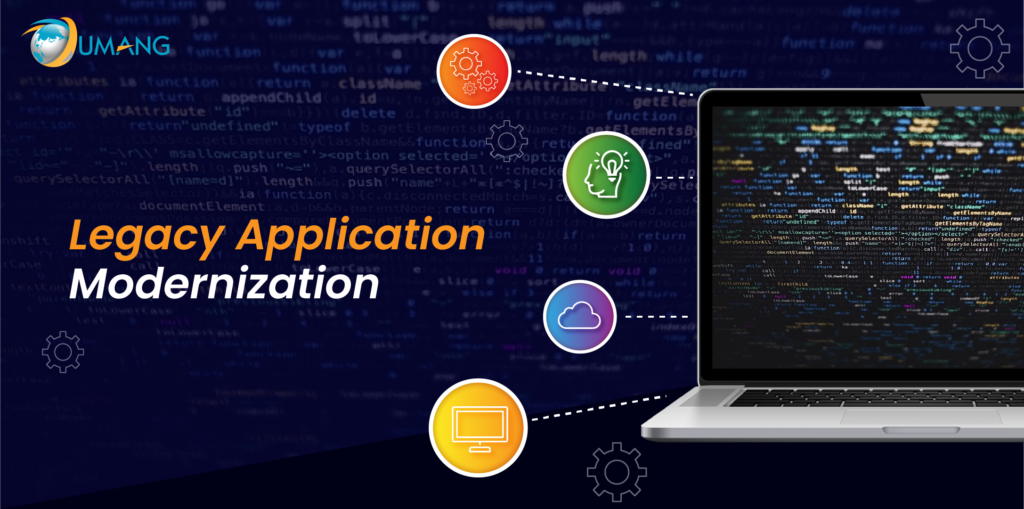In the past few years, digital transformation has become a buzz. However, the reality will not overshadow the importance of transforming existing products and processes to attract and retain customers, remain competitive and drive business growth. As of 2022, 70% of companies have started using digital technologies and optimizing their existing business for better user experience, business resiliency, and employee productivity.
In the IT world, the digital transformation includes modernizing the legacy system and processes to enhance efficiency and infuse intelligence for the business’s success.
This blog explores what constitutes a legacy system and how it benefits business and provides a straightforward guide for the organization on success.

What is a Legacy Application?
When an existing application becomes obsolete and no longer functions correctly, and can’t complete the business requirement, a practice of upgrading and updating the current application is followed which is known as legacy app modernization. The purpose is to make the application run efficiently in the modern world and compete with other applications.
App modernization is currently the common thing for businesses over digital transformation.
Why Modernization of Legacy Apps?
The IT sector is changing drastically with each passing day, and in a year, numerous new technologies bring new updates to old apps. Due to this, the current business software tends to become outdated and leads to problems. Some common problems organizations are facing include:
1. Non-availability of maintenance and support services for older versions
2. Known and unknown security vulnerabilities.
3. It is tough to find an expert to work with legacy systems.
4. Incompetent against modern solutions.
5. The older version incurs a higher maintenance cost.
Due to all these challenges, businesses require updating, rebuilding, and replacing the existing apps.
Key technologies For Application Modernization
1. Containers and Kubernetes
Containers are the approaches to packaging, deploying, and operating executable software units in the cloud. The benefits are scalability and portability. However, the Kubernetes is a container – orchestration system for automation of the process.
2. Orchestration and Automation
The individual task will run independently in automation, but orchestration automates multiple functions. These will introduce networking, security, scaling, and efficiency of deployment.
3. Microservices
Usually, legacy applications are monolithic, which means self-contained single-tier applications. This modernization makes it easy to achieve the agility to meet the changing customer and employee expectations. For this, many companies adopt microservices that emphasize services connected by API and enable the companies to select the best solutions to meet the customer expectations.
4. Cloud
It is one of the standard practices in the modernization process. Private, public and hybrid cloud services help the business enhance the functionality of apps and even at a reduced cost than on-premises infrastructure.
Methods for App Modernization
The common approaches for the app modernization:
1. Rebuilding
It means rewriting the existing app code from scratch while maintaining its original scope. However, to rebuild the application, the companies will search for components to modernize it. It is the best alternative rather than writing whole new code.
2. Rehosting
It is also known as re-platforming or lift and shift. It involves transferring components to modern hardware or the cloud; however, rehosting the code changes may or may not be required due to compatibility between the app and host portals.
3. Rearchitecting
It includes changing and optimizing existing code to enhance the performance of the legacy system. Rearchitecting is the best option for an upgrade rather than creating a new code; rearchitecting is the best option for upgrading.
4. Replacing
It means replacing the existing app and rewriting it with off-shelf solutions. But replacing will be an expansive approach. If the three methods mentioned above are now working, then replacement is an ideal choice.
Benefits of Legacy Application Modernization
It enables the companies to leverage the benefit of new development by replacing the cost of their legacy systems. The benefits are:
- Enhanced performance and reliability
- Reduced maintenance cost
- Use new technology without starting from scratch.
- Maintain legacy business rules
- Increased use and value of existing IT assets.
Upgrade Technology with Legacy System Modernization
Sticking to legacy apps may affect a company’s efficiency and prospects. But modernization enables you to maintain abreast of advanced technology and gives your business new opportunities to grow in a competitive world.